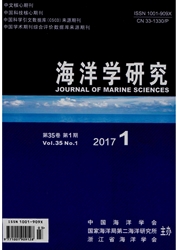

 中文摘要:
中文摘要:
利用中国Argo实时数据中心提供的9a(2000-2008年)网格化Argo剖面浮标温、盐数据(G-Argo),分析热带太平洋障碍层厚度的气候态分布和低频变化特征。气候平均结果表明,较厚的障碍层主要出现于西太平洋暖池区,并有3条纬向障碍层带状分布,从暖池出发向东延伸至120°W,分别位于以15°N°5°N和12°S为中心的纬度带上。经验正交函数(EOF)基本模态分析表明,热带太平洋障碍层低频振荡以季节和年际变化为主,在季节尺度上主要表现为15°N和12°S障碍层纬度带呈反相变化,都在当地冬季最大,夏季最小;在年际尺度上则主要表现为暖池东边界附近障碍层与厄尔尼诺一南方涛动(ENSO)相关的变化,以及暖池中部障碍层与热带准2a周期振荡(TBO)相关的变化。
 英文摘要:
英文摘要:
Based on nine years (2000--2008) of gridded Argo (G-Argo) temperature and salinity data from China Argo Real-time Data Center, the climatological distribution and low-frequency variability of the barrier layer thickness (BLT) of the tropical Pacific Ocean was analyzed. The climatological mean BLT distribution is characterized by relatively large values in the western Pacific warm pool, and three latitudinal bands that extends from the warm pool to 120°W, centered at approximately 15°N°5°N, 12°S, respectively. The leading EOF modes indicate that the low-frequency variability of the tropical Pacific BLT is dominated by seasonal and interannual signals. For the seasonal time scale, the most pronounced mode is an antiphase BLT pattern at the latitudinal bands along 15°N and 12°S, with the largest (smallest) thickness in winter (summer) at the respective hemisphere. For the interannual time scale, there are two important modes of BLT variability, one located near the eastern boundary of the warm pool with a strong correlation to ENSO, and the other centered at the middle of the warm pool, probably related to TBO.
 同期刊论文项目
同期刊论文项目
 同项目期刊论文
同项目期刊论文
 A scheme to identify loops from trajectories of oceanic surface drifters: an application in the Kuro
A scheme to identify loops from trajectories of oceanic surface drifters: an application in the Kuro Different effects of tropical cyclones generated in the South China Sea and the northwest Pacific on
Different effects of tropical cyclones generated in the South China Sea and the northwest Pacific on Teleconnections of the tropical Atlantic to the tropical Indian and Pacific Oceans: A review of rece
Teleconnections of the tropical Atlantic to the tropical Indian and Pacific Oceans: A review of rece Using satellite ocean color data to derive an empirical model for the penetration depth of solar rad
Using satellite ocean color data to derive an empirical model for the penetration depth of solar rad Typhoon-induced variability of oceanic surface mixed layer observed by Argo floats in the western No
Typhoon-induced variability of oceanic surface mixed layer observed by Argo floats in the western No Interdecadal variability of eastward current in the South China Sea associated with the Summer Asian
Interdecadal variability of eastward current in the South China Sea associated with the Summer Asian Further analysis of singular vector and ENSO predictability in the Lamont model-Part II: singular va
Further analysis of singular vector and ENSO predictability in the Lamont model-Part II: singular va Interaction between the East China Sea Kuroshio and Ryukyu Current as revealed by the self-organizin
Interaction between the East China Sea Kuroshio and Ryukyu Current as revealed by the self-organizin 期刊信息
期刊信息
